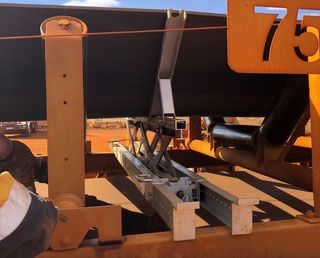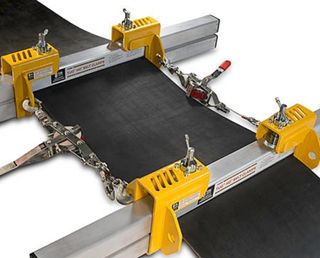Three Tools to Make Belt Conveyor Maintenance Quicker and Safer
Did you know that the Australian Mining industry has the third highest fatality rate of any industry, with an average of 9 workers dying each year? (Safe Work Australia, 2021).
Safe Work Australia found 2105 accepted claims of serious injury or illness in the mining sector in 2014-15, which was up 51% since 2000-01. Plus, body stressing (health problems related to repetitive and strenuous work) represented 39% of compensation claims - many of these were due to muscular stress handling objects, carrying, or putting down objects. In Western Australia alone, the Department of Mines, Industry Regulation and Safety estimated 429 lost time injuries during 2019-20, resulting in 10,568 days lost and a further 13,162 rostered days of restricted work.
Why are we sharing this info with you? We want you to better understand the importance of limiting every opportunity that could put your worker’s safety at risk, and severely affect your productivity. While you can’t control all the variables that come with working in tough conditions – inclement weather, abrasive materials, etc. – you can control how you prepare for safe belt repairs.
Ultimately, safe conveyor belt maintenance starts with choosing the right tools – that have been engineered with safety as a top priority. So, here are the top three tools that will make your belt repair process easier, faster, and safer.
Tool 1: Conveyor Belt Lifters
 |
| The Flex-Lifter™ Belt Lifter holding a conveyor belt. |
Lifting a tensioned conveyor belt out of the way to do maintenance work is a difficult job. It can be both time-consuming and dangerous for operators. When lifting a conveyor belt without a safe support tool, there is a high risk of injuries because improper tools can fail, you’re working with suspended loads, and workers can become fatigued from manual handling.
The Flex-Lifter™ Belt Lifter puts an end to pry bars and manual lifting. It is designed to support and lift conveyor belts up to 2400mm wide and has a safe lift rate of 2725kg. The versatile tool has adjustable wings that make it easy to lift troughed or flat topside belts. It truly makes a difficult and hazardous job easier and safer – check it out for yourself in this video of the belt lifter in operation.
Tool 2: Engineered Belt Clamps
 |
| TUG™ HD® Belt Clamps complete set up. |
In addition to locking and tagging out your belt conveyor system and wearing proper PPE, clamping your belt properly is one of the most important steps you can take to avoid a catastrophic event. It doesn’t matter if you are 50 meters off the ground, or 50 meters underground, clamping is one of the most important safety precautions you can take during a repair.
Keep in mind that serious injuries are possible when clamping is done without using the proper tools and products – which has been explained in our blog homemade VS engineered belt clamps. TUG™ HD® Belt Clamps are designed to secure the belt by clamping over it for greater strength in higher-load applications rated from 6- to 8-tonnes, making them ideal for mining applications. They are third-party tested, and the safety factors of clamp ratings meet or exceed industry standards. It’s time to say goodbye to homemade devices like c-clamps, lumber, and chains.
Solution 3: Electric Belt Cutters
 |
| Cordless Belt Cutter. |
Utility knives simply can’t provide the same level of safety, speed, and accuracy when cutting belts. Power assisted belt cutters minimize the danger of accidental injury during the belt cutting process and provide a smooth, accurate cut. For example, a safety-conscious power plant replaced their utility knives with a cordless belt cutter that reduced their average finger splice time to only 20-25 minutes and required only one worker to complete the job.
Available in both corded and cordless versions, Flexco Electric Belt Cutters quickly and easily cut all types of belting from the softest of natural rubbers to the hardest constructed solid woven PVC and fabric plied belts. The tool cuts up to 2” on rubber belts and up to a maximum 360 P.I.W. on PVC belts. Operators are protected by a spring-loaded blade guard and can feed the cutter into the belt with minimal effort because of the sealed ball bearings.
TIP: Always square your belt
Effective belt repairs start with straight, square cuts. Squaring your belt ends is a job that requires only a few minutes of your time and offers real paybacks in extending your belt splice life. Here is a step-by-step guide on how you can properly square your belt before cutting.
Train your team
Even well-designed and well-built maintenance tools can malfunction or become hazardous in the hands of an inexperienced or untrained user. Operators must be thoroughly trained before operating conveyor belt lifters, belt clamps and electric belt cutters. Flexco is currently offering free demonstrations on any of the three maintenance tools by trained Flexco personnel. Book a free demonstration here to ensure you provide maximum safety for all operating personnel, and to get a maximum benefit from your equipment.
Authored by: Ellaina Mackay, Product Manager
Mackay joined Flexco in 2018 as the Marketing Communications Coordinator. Over her years working at Flexco she has proven her expertise and knowledge across the mining and metals industry, leading into her new role as the National Product Manager in 2021. She now manages the overall product strategy for Flexco Australia.
Subscribe to the Flexco Blog
Related Blogs
Published Date
October 26, 2021Product Group
- Belt Maintenance Tools
Issues
- Belt Damage
- Belt Preparation
- Belt Protection
- Maintenance